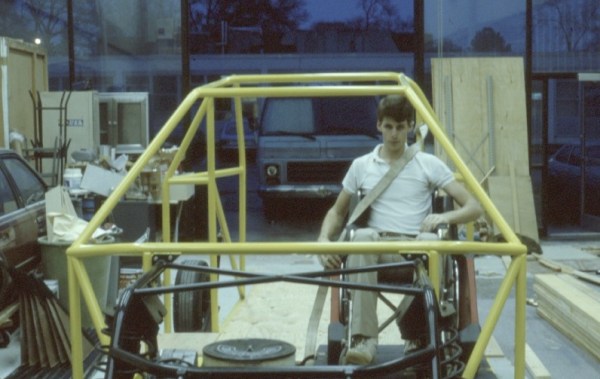Jason’s post from earlier today brought back memories of a student project I worked on while studying Industrial Design in the mid-1980s at Georgia Tech. The “Universal Car” was a project for the Center for Rehabilitation Technology (now called the Center for Assistive Technology and Environmental Access), part of Tech’s College of Architecture. At this time, the Dodge Caravan had only been on the market a year or two, so options for wheelchair users were limited mostly to full-size van conversions. This project had the intent of creating a more personal, user-friendly and stylish option for the market.
The ID class the year before had done some initial concept work and had established that the vehicle would have a kneeling rear suspension which would grant access through a rear door up the resulting gently-sloping flat floor. I refined the concepts and while I was unable to locate any of my renderings of the exterior (analog, not 3D!), in hindsight, it would have looked similar to an enlarged Ford Aerostar.
From the concepts, dimensioned drawings were created which a local race-car builder used to fabricate the car’s frame. GM donated a new (1985) Cutlass Sierra that had been smoke-damaged in a fire (and thus could not be sold), which provided a 3.0l V6 engine and transaxle for the vehicle. It’s the only time in my life I’ve had the opportunity to remove a pristine, completely clean engine from a car!
In a separate ID project, I designed a wheelchair restraint system which was intended to provide better reinforcement for the chair structure in the event of a crash:
Most restraint systems at that point worked by simply clamping the wheelchair wheels to the floor—in a crash, either the wheel itself would collapse, or the chair structure would fall apart. My system cradled the large wheel and provided bolsters to aid in keeping the occupant in place.
By the end of the school year, we had a rolling frame assembled. Later classes would do additional work on the vehicle, but it unfortunately would never get finished to the point of being a driver. As minivan conversions became more prevalent, they filled the need for which the Universal Car had been intended, making it less relevant.
In hindsight, while the design work on the car was both fun and significant, what really made the deepest impact was the relationships I built with numerous folks at the Roosevelt Warm Springs Rehabilitation Center in Warm Springs, GA, who taught me a lot about persevering through difficulties, no matter what life throws at you.





























Do I see a GMC Motorhome behind you in the last pic?
That caught my eye right away too! Plus the Ciera carcass on the side.
Indeed! I forget why the school had it, possibly part of another project.
This is fascinating. It’s amazing how far things have evolved since 1985.
Isn’t that a scale model in the back ground in pictures #3 and #5 along with a drawing in pic #5.
Yes, that was the original concept from the year before. It got less boxy with my revisions, which included a much more steeply raked windshield.
It is so interesting watching to see how people of different backgrounds and fields set out to solve a problem. The engineering school sets out to do a clean-sheet design, and comes up with some really good ideas. Then, a self-taught guy like Ralph Braun, who uses a wheelchair, sees the possibilities of something smaller than a big van and starts hacking up a factory minivan. Two completely different solutions to the same problem.
Do I see a model of the vehicle in the background of the third and sixth photos?
Yep, that was the original concept done by the class ahead of me. After I restyled the car, I made a scale clay model. Not sure where those photos are these days… Probably in a box in the attic.
This seems like the SAE College Challenge Version of (precursor to) the MV1.
This was a cool project, Ed. Thanks for sharing it.
While the minivan conversions might have made the concept less practical, conversions for the handicapped and the elderly is going to continue to grow. While, I am certainly not limited in mobility in any way, I do have arthritis in the knees which requires that I pay attention to leg room and seating position in a car. It also eliminates certain types of vehicles from consideration. Some of my experiences, made me think about getting into this field actually in terms of conversions for those with specific ailments. I foresee a need for these services growing in the coming years as the baby boomers, and our population in general ages.
Don’t know how I missed this the first time around. Great story.